The Hurricane’s career as a day fighter in the European theatre of operations came to an end during the aerial offensives of early 1941. By then, the Mk.I was already outclassed, while the introduction of the improved Mk.II variant did not give the RAF an advantage over the Messerschmitt Bf 109, for at more or less the same time the Luftwaffe received a markedly improved version of the fighter.
The production of Hurricanes increased, however, and peaked in mid-1942, when nearly 250 of the aircraft were manufactured monthly. Hundreds were sent to less demanding theatres of war, and, from the second half of 1941, to the Soviet Union, which had just been forced to change sides in the global conflict. Many day fighter Hurricane squadrons stationed in Great Britain were reinvented as night fighter units, with some being assigned to the rather unsuccessful Turbinlite teams. The best decision as to how further utilise the mass-produced but ageing aeroplane was, by all accounts, inspired by the Luftwaffe, which became the first air force to employ single-engined fighters as fast bombers; aircraft of this type, although carrying a relatively modest payload, were able to attack with the element of surprise and easily avoid enemy counteraction through modified tactics and their superior speed
Hurricane IIb from the 402 squadron is being armed with 250-lb bombs. MG over a bomb rack is removed and a barrel hole is secured with tape. Photo: IWM/Wikimedia Commons.
In 1941, the Hurricane was the Allies’ most obvious candidate for the role of fast bomber, for it could carry 1000 lb of bombs – just as much as the twin-engined Bristol Blenheim bomber.
Service With No. 402 (Canadian) Squadron
And here begins the story of our BE489, which, while serving with No. 402 (Canadian) Squadron, was among the first Hurribombers to attack German targets in occupied France.
The unit flew the Hurricane from the start of its involvement in combat in March 1941. Already at the end of April, it received the new Mk.II version, which it proceeded to use with some measure of success in offensive operations over France; in any case, losses in combat with Luftwaffe fighters were less than the number of victories reported.
The First Bombing Raid
On 24 August 1941, two pilots from the squadron – S/L Corbett and F/O Foster – were sent to the Air Fighting Development Unit in Duxford, where initial attempts were being made to adapt the Hurricane for its new role. At the beginning of October, the entire No. 402 (Canadian) Squadron, at the time stationed at RAF Southend, commenced bombing training, and on 1 November it bombed and strafed the German airfield at Berck-sur-Mer, thus marking the beginning of a completely new chapter in its history. The eight Canadian Hurribombers which took part in the assault were provided with an escort of Spitfires from the 1st Polish Fighter Wing, which comprised three squadrons, Nos. 303, 308 and 315. On this debut, BE489 was piloted by F/O Kelly. The airfield was raided again on 4 November, while on 11 November – by then having been deployed to Warmwell – the unit bombed the ammunition depot at Forêt de Saint-Saëns. During the second attack on Berck-sur-Mer, BE849 was flown by Sgt. Handley, who turned out to be one of its most frequent operators. On 11 November, the squadron suffered its first operational loss of a Hurribomber when Sgt. Vair most probably flew into the ground while approaching his target.
Hurricane Mk IIb, BE489/AE-Q, dropping two 250-lb bombs. Artwork by Marcin Górecki.
At Warmwell
The unit’s transferral to Warmwell in South England meant that it would also be used to combat German naval vessels and provide escort cover for British convoys. On 25 November, the squadron raided the airfield at Le Morlaix, however our BE489 remained at base. A day later, “Butch the Falcon”, flown by F/O Hally and with two 250 lb bombs under its wings, left Warmwell with the task of destroying a ship which had been sighted by a reconnaissance patrol near the port of Cherbourg. The vessel was not located, however, and the pilot returned empty-handed.
The remainder of the month was devoted mainly to training. On 27 November, tests were undertaken in order to determine how the Hurricane would cope with a bomb load of two five hundred pounders. The winter months turned out to be a period of limited military activity for the squadron. In December, its pilots completed just under 61 operational flying hours, mainly on two-plane convoy patrols, but also while attempting (unsuccessfully) to intercept intruders from the other side of the English Channel. No contact was made with the enemy. Training was considerably more intensive, however: 384 hours were flown, that is roughly 20 per each aircraft in the squadron, in comparison with barely 217 hours in November.
The First Aerial Combat
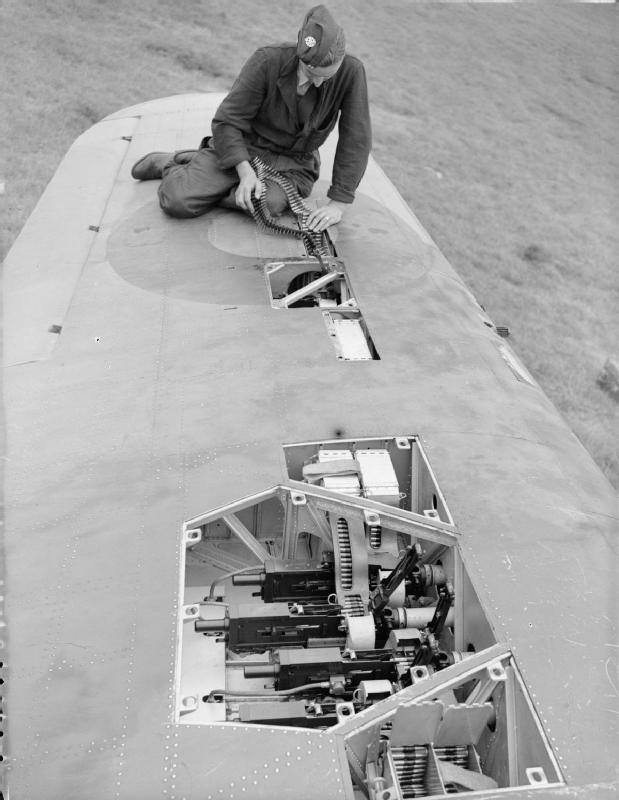 January started off unluckily for the unit. On 2 January, a pair of Hurribombers reconnoitring German ships in the vicinity of Cherbourg was jumped by four Messerschmitt Bf109s, and Sgt. O’Neill’s aircraft was shot down into the sea during their initial attack. The other pilot, P/O Ford, although under heavy fire, managed to run for the clouds. Since their mission had been interrupted, the planned operation against enemy surface vessels was aborted. The remainder of January was filled with training, which would regularly be suspended for a day or two due to the inclement winter weather. The sole moment of drama occurred on 10 January, when two aeroplanes collided during a training flight; one had to make a forced landing but its pilot, F/L Kelly, escaped injury, while the second, flown by Sgt. Macklem, landed back at base in a condition precluding any on the spot repairs. Interestingly, both aircraft were later returned to service, albeit in different squadrons. January ended with a total of twenty sorties being flown, during which – with the exception of the engagement of 2 January – no contact was made with the enemy.
January started off unluckily for the unit. On 2 January, a pair of Hurribombers reconnoitring German ships in the vicinity of Cherbourg was jumped by four Messerschmitt Bf109s, and Sgt. O’Neill’s aircraft was shot down into the sea during their initial attack. The other pilot, P/O Ford, although under heavy fire, managed to run for the clouds. Since their mission had been interrupted, the planned operation against enemy surface vessels was aborted. The remainder of January was filled with training, which would regularly be suspended for a day or two due to the inclement winter weather. The sole moment of drama occurred on 10 January, when two aeroplanes collided during a training flight; one had to make a forced landing but its pilot, F/L Kelly, escaped injury, while the second, flown by Sgt. Macklem, landed back at base in a condition precluding any on the spot repairs. Interestingly, both aircraft were later returned to service, albeit in different squadrons. January ended with a total of twenty sorties being flown, during which – with the exception of the engagement of 2 January – no contact was made with the enemy.
Armamament of the Hurricane Mk IIb consist six .303 (7.69 mm) machine guns in each wing. Photo: IWM/Wikimedia Commons.
Anti-Shipping Missions
February began just like the previous months. Things got more interesting only on the 10th, when an offensive anti-fleet operation was launched, engaging four aircraft escorted by Spitfires from Nos. 234 and 501 Squadrons. No targets were found, however, and the planned assault came to nothing. Neither did the squadron take an active part in Operation Channel Dash (11–13 February 1942), although the Hurribombers with their 500 lb bombs arguably had the potential to play an important role in preventing the Nazi battleships from relocating from Brest to Germany. On the afternoon of 12 February, the unit was moved to Manston, from where it was intended to be used in this capacity, however it did not join the fight. Just when it was waiting to take off from Manston, the “Scharnhorst” struck a mine and was forced to a temporary halt, which doubtless made it an easier target. But the opening was not exploited, and the Hurribombers, instead of covering themselves in eternal glory, returned to base after barely an hour of flight.
The Last Victories
In the late evening of 16 February, six Hurribombers took off from Perranporth and headed towards Brest on a sweep; an opportunity had finally arisen to make use both of the experience gathered over hundreds of hours of training, and the aeroplane’s capabilities. Reconnaissance had reported trawlers in the area, however the Canadian pilots identified these as destroyers. Pressing home their attack, they scored one direct hit on a German vessel and managed to drop a few bombs in the immediate vicinity of the target group. The former was considered to have been seriously damaged, and was in fact listing to stern when the Canadians were leaving the battle-field, while another ship was thought to have suffered damage from near misses. I was unable to determine what types of vessels had actually been attacked by the Canadians.
This successful action and the expected improvement of weather conditions in spring appeared to portend a period of increased combat activity. The next day, while the squadron was returning from Perranporth to Warmwell, Sgt. Emberg lost contact with the rest of the flight due to poor visibility. For some time, he flew in a pair with Sgt. Keene, however his companion abruptly disappeared in the clouds. Emberg started circling and looking for him, but instead of a Hurricane, he saw a Messerschmitt Bf 109F burst from the cloud-bank. He therefore jettisoned his bombs, picked up speed, and attacked the enemy aircraft. Having fired three bursts, which consumed approximately 1,400 bullets, he witnessed his foe crash into the sea. Flying very low in order to take a closer look at the wreckage, he was himself attacked by two Messerschmitt Bf 109s. Jinking to avoid his pursuers, he managed to gain height and hide in the low-lying clouds. The Germans had, however, damaged Emberg’s aeroplane to the extent that he had no option but to make a forced landing. His lost comrade, Sgt. Keene, also crash-landed after exhausting his fuel. Emberg’s was the sole aerial victory achieved by No. 402 (Canadian) Squadron while it was equipped with the fighter-bomber variant of the Hurricane.
Colour profile of the Hurricane BE489, beginning 1942. Artwork by Zbigniew Malicki.
A Farewell to No. 402 (Canadian) Squadron
But the engagement failed to kickstart any lengthier period of success for the Hurribombers of No. 402 (Canadian) Squadron. On 23 February, another attempt was made to attack German shipping in the vicinity of Brest. The aircraft once again took off from Perranporth, however this time no targets of note were found. On the same day, Sgt. Eady, who was on a training flight, collided with a pylon and perished. The last day of February was spent on convoy patrols, which were performed in pairs. BE4989, piloted by Sgt. Handley, took part in the final sortie of the month, which was also the last operational Hurricane flight performed by No. 402 (Canadian) Squadron.
On 4 March, the unit was moved to Colerne, leaving its aircraft in Warmwell along with four pilots who were to assist in the formation and subsequent bombing training of a new squadron, No. 175, which, as it turned out, operated the Hurribomber throughout the next year. No. 402 (Canadian) Squadron was re-equipped with Spitfires and returned to its purely fighter role for a longer period of time. The rationale behind this decision is difficult to understand, especially as an enormous amount of effort had been put into developing effective combat tactics for the Hurribomber, and hundreds of hours expended on the training of pilots who, after a few months of flying, had finally started to feel comfortable in their role.
Our BE489 was later used extensively by No. 175 Squadron, and among others took part in Operation Jubilee, luckily returning to base from both its flights. But luck deserted it on 23 June 1943, when, while being operated by No. 55 Operational Training Unit RAF, it collided with another Hurricane and crashed, killing its Canadian pilot, F/O Graves.
Colours and markings of the Hurricane BE489

The paint scheme and markings of the model have been recreated on the basis of very scant source materials, one photograph published in Chaz Bowyer’s “Hurricane at War” (reprinted in Philip Birtles’ “Hurricane Squadrons in Focus: The Photographic History of RAF Hurricane Squadrons in Europe 1939 to 1945”), and relatively more detailed data from Phil Listemann’s brochure (No. 26) in the “Squadrons!” series. Apart from the comic-book emblem, it looks like any other typical Hurricane in Day Fighter Scheme. The code letter on the underside front of the fuselage was painted asymmetrically, and this fact should be taken into consideration when applying transfers.
“Butch the Falcon”, Hurricane BE489 insignia. Artow0rk by Zbigniew Malicki.
It is not known when exactly BE489 received its emblem and name, “Butch the Falcon”, which was written in letters too small to ensure their visibility on a transfer on a scale of 1/72. Correspondents from the Moving Pictures Unit visited the squadron on 23 November 1941. The film which they shot is available in the internet, however it does not show any aircraft with non-regulation markings. The emblem only becomes apparent on aeroplane photographs from February 1942. We may therefore safely assume that the reconstruction proposed for our Hurribomber model provides a faithful representation of its appearance during the last month of service with No. 402 (Canadian) Squadron.
- Link to the film. Logo and film are AP property.
English Translation by Maciej Zakrzewski
Zobacz jeszcze:
- Kup modele Hurricane w sklepie Arma Hobby
Model maker for 45 years, now rather a theoretician, collector and conceptual modeller. Brought up on Matchbox kits and reading "303 Squadron" book. An admirer of the works of Roy Huxley and Sydney Camm.
This post is also available in:
 polski
polski





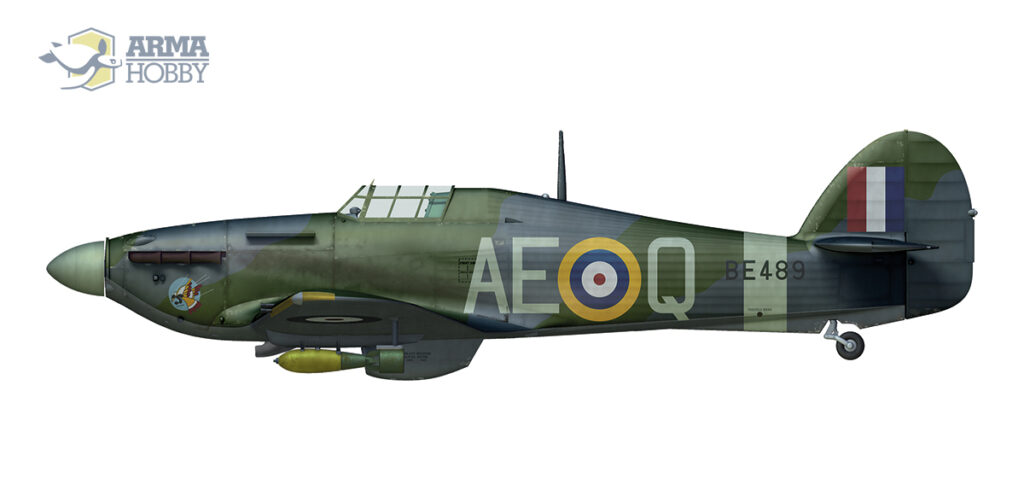

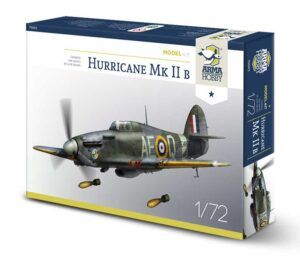
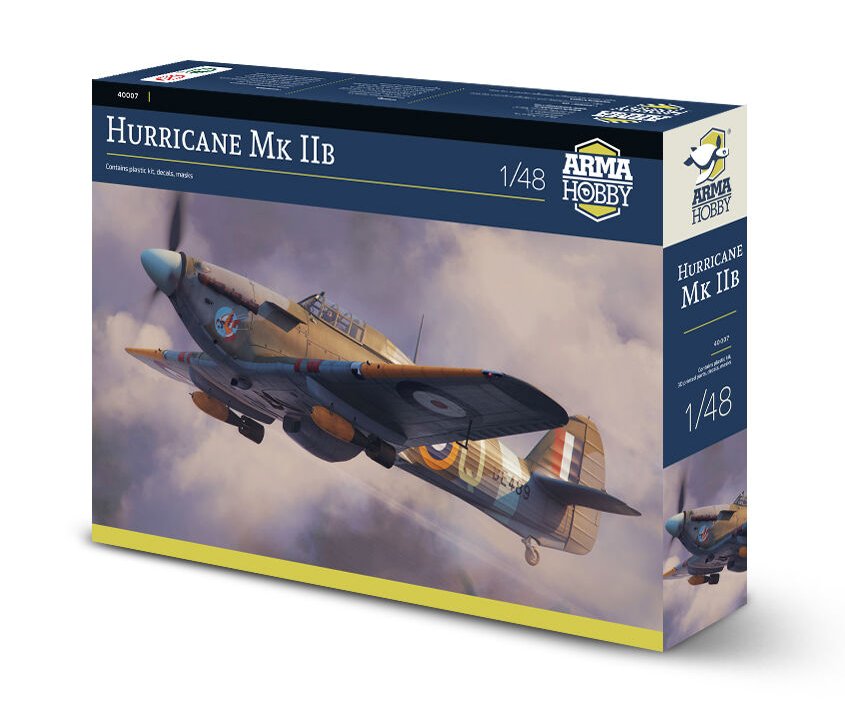
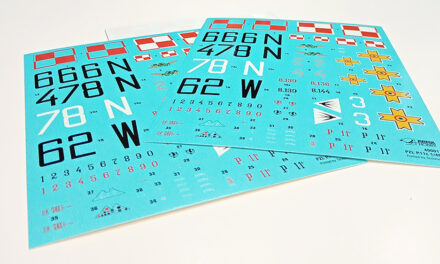



No.402 Squadron RCAF when equipped with the Hurri-bomber were tasked on the Channel Stop, and while they would have preferred to have been on the Spits, their task was nonetheless successful.